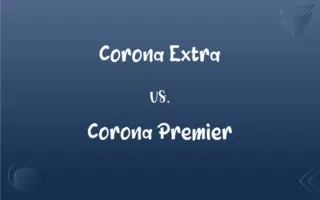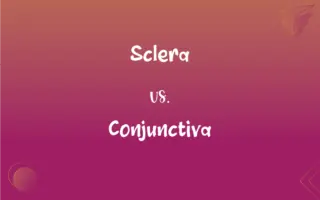FDM vs. WDM: What's the Difference?
Edited by Aimie Carlson || By Janet White || Published on November 13, 2024
FDM (Frequency Division Multiplexing) separates channels by frequency, while WDM (Wavelength Division Multiplexing) separates optical channels by different wavelengths of light.

Key Differences
FDM is a technique where multiple signals are combined for transmission on a single medium by assigning each signal a different frequency band. WDM, specifically used in fiber optics, combines multiple light wavelengths for transmission over a single fiber.
FDM is commonly used in radio and television broadcasting, where different channels are transmitted at different frequency bands. WDM is crucial in telecommunications, particularly in long-distance fiber optic cables, to increase bandwidth by carrying different data streams on various light wavelengths.
In FDM, the total bandwidth is divided into non-overlapping frequency bands, each carrying a separate signal. In WDM, each channel uses a different light wavelength, allowing simultaneous transmission of multiple signals over the same fiber.
FDM can be affected by issues like interference and cross-talk between frequency bands. WDM, however, faces challenges like dispersion and non-linear effects in the fiber, affecting signal quality over long distances.
FDM technology is older and more suited for analog signals, whereas WDM is a newer technology, highly efficient for digital data transmission in modern high-speed fiber optic networks.
ADVERTISEMENT
Comparison Chart
Medium of Use
Radio, television broadcasting
Fiber optic cables for telecommunications
Signal Separation
By frequency bands
By light wavelengths
Primary Application
Analog signal transmission
Digital data transmission
Key Challenges
Interference, cross-talk
Dispersion, non-linear effects
Technological Era
Older, more suited for analog technologies
Newer, optimized for digital communication
ADVERTISEMENT
Bandwidth Utilization
Limited by frequency range
Higher, due to multiple light wavelengths
Signal Integrity
Prone to interference
Better signal integrity over distances
Capacity
Lower compared to WDM
Higher, more efficient in data handling
Complexity
Less complex technology
More complex due to light properties
Cost
Generally less expensive
More expensive due to advanced technology
FDM and WDM Definitions
FDM
FDM is widely used in analog broadcasting systems.
The traditional TV broadcasting system employed FDM to transmit multiple channels.
WDM
WDM is particularly effective in long-distance fiber-optic communication.
Telecommunication companies use WDM to carry large amounts of data over long distances.
FDM
In FDM, each channel's frequency band is separated by a guard band to prevent overlap.
FDM uses guard bands to prevent interference between adjacent frequency channels.
WDM
WDM enhances bandwidth efficiency by carrying multiple light signals simultaneously.
WDM's ability to carry different data streams concurrently makes it highly bandwidth-efficient.
FDM
FDM divides the available bandwidth into separate frequency bands for each signal.
FDM ensures that telephone conversations don't interfere with each other by assigning different frequencies.
WDM
WDM can be divided into Dense WDM (DWDM) and Coarse WDM (CWDM), based on channel spacing.
DWDM allows for more channels than CWDM by using closer wavelength spacing.
FDM
FDM is a method of transmitting multiple signals simultaneously over a single transmission path.
Radio stations use FDM to broadcast multiple channels at different frequencies.
WDM
WDM requires precise wavelength control for effective signal transmission.
Accurate wavelength control is essential in WDM to prevent signal overlapping and ensure clear transmission.
FDM
FDM can suffer from cross-talk and frequency interference.
The main drawback of FDM is the potential for cross-talk between closely packed frequencies.
WDM
WDM is a technology that multiplexes multiple optical signals on a single fiber by using different wavelengths.
WDM significantly increases the capacity of a single fiber by using different wavelengths for each signal.
FAQs
What does FDM stand for?
FDM stands for Frequency Division Multiplexing.
Can FDM be used for digital signals?
Yes, but it's more commonly used for analog signals.
What is the main use of FDM?
FDM is mainly used in radio and TV broadcasting.
Is FDM suitable for fiber optic communication?
Not typically, WDM is better suited for fiber optics.
Is WDM used in analog or digital systems?
WDM is primarily used in digital systems.
What are the limitations of FDM?
FDM's limitations include cross-talk and frequency interference.
What does WDM stand for?
WDM stands for Wavelength Division Multiplexing.
Is WDM more cost-effective than FDM?
WDM is more expensive but offers higher bandwidth efficiency.
How does FDM affect bandwidth?
FDM divides the total bandwidth into separate frequency bands.
What are the types of WDM?
The main types are Dense WDM (DWDM) and Coarse WDM (CWDM).
What is the key advantage of WDM?
WDM's key advantage is its high bandwidth capacity in fiber optics.
Does FDM require specialized equipment?
FDM requires less specialized equipment than WDM.
Do FDM and WDM have different applications?
Yes, FDM is used in broadcasting, while WDM is used in high-speed fiber optics.
Can FDM be used in mobile communications?
Yes, but it's more common in stationary broadcasting systems.
Can WDM be used for short-distance communication?
Yes, but it's more advantageous for long-distance communication.
What are guard bands in FDM?
Guard bands in FDM are frequency gaps to prevent overlap.
How does WDM improve network capacity?
WDM improves capacity by using multiple wavelengths in a single fiber.
Are FDM and WDM compatible?
They serve different purposes and are not typically used together.
What is wavelength control in WDM?
It's the precise management of light wavelengths to prevent signal overlap.
Can WDM be affected by signal dispersion?
Yes, signal dispersion can affect WDM in long-distance transmission.
About Author
Written by
Janet WhiteJanet White has been an esteemed writer and blogger for Difference Wiki. Holding a Master's degree in Science and Medical Journalism from the prestigious Boston University, she has consistently demonstrated her expertise and passion for her field. When she's not immersed in her work, Janet relishes her time exercising, delving into a good book, and cherishing moments with friends and family.
Edited by
Aimie CarlsonAimie Carlson, holding a master's degree in English literature, is a fervent English language enthusiast. She lends her writing talents to Difference Wiki, a prominent website that specializes in comparisons, offering readers insightful analyses that both captivate and inform.







































































